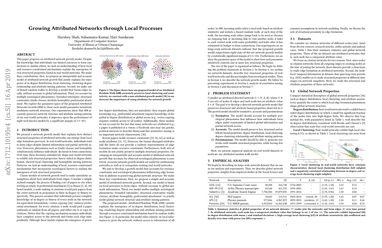Growing Attributed Networks through Local Processes
This paper proposes an attributed network growth model. Despite the knowledge that individuals use limited resources to form connections to similar others, we lack an understanding of how local and resource-constrained mechanisms explain the emergence of rich structural properties found in real-world networks. We make three contributions. First, we propose a parsimonious and accurate model of attributed network growth that jointly explains the emergence of in-degree distributions, local clustering, clustering-degree relationship and attribute mixing patterns. Second, our model is based on biased random walks and uses local processes to form edges without recourse to global network information. Third, we account for multiple sociological phenomena: bounded rationality, structural constraints, triadic closure, attribute homophily, and preferential attachment. Our experiments indicate that the proposed Attributed Random Walk (ARW) model accurately preserves network structure and attribute mixing patterns of six real-world networks; it improves upon the performance of eight state-of-the-art models by a statistically significant margin of 2.5-10x.
PDF Abstract